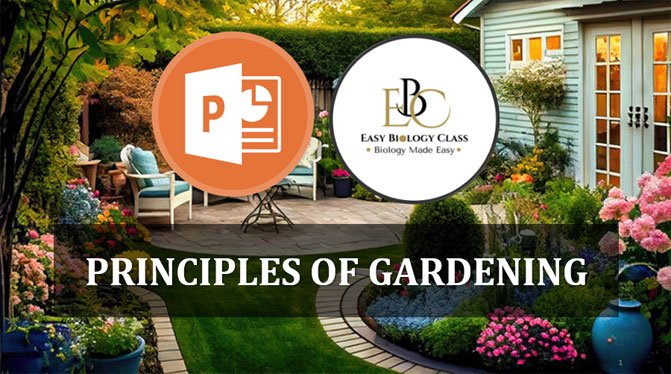Principles of Gardening PPT: The principles of garden design and site selection focus on creating a harmonious and functional outdoor space. Unity and harmony ensure all elements blend seamlessly, while balance—whether symmetrical or asymmetrical—maintains visual stability. Proportion and scale help establish the right size relationships, and a well-placed focal point draws attention to key features. Contrast and variety, along with texture and color, add depth and visual interest, while light and shadow enhance the garden’s ambiance. Lastly, functionality and flow ensure ease of movement, and stability guarantees long-term durability in design.
| What is Garden? Types of Garden, Flower Garden, Vegetative Garden, Botanical Garden, Water Garden, Rock Garden, Gardening Activities, Soil Preparation, Planting, Watering, Weeding, Pruning, Harvesting, Principles of Garden Design, Unity and Harmony, Balance, Proportion and Scale, Focal Point, Contrast and Variety, Texture and Colour, Light and Shadow, Functionality and Flow, Stability |
Principles of Gardening PPT
How to Download PPT from EasyBiologyClass?
I hope you found this PPT on Principles of Gardening is informative and beneficial. Your feedback and comments would be greatly appreciated. Whether you have suggestions, questions, or thoughts to share, I would be delighted to hear from you. Engaging with your comments helps me continue to produce high-quality content in Biology. Please feel free to leave a comment below. Thank you for your support.
Regards: Admin, EasyBiologyClass
Principles of Gardening (Slides Handout)
What is a Garden?
A garden is a designated outdoor space for growing plants, flowers, herbs, vegetables, or trees. Gardens can be ornamental, designed primarily for beauty and enjoyment, or functional, intended for food production. They range in size from small personal plots in backyards to large botanical gardens or public parks.
What is Gardening?
Gardening is the practice of tending and cultivating a garden. It involves soil preparation, planting, watering, weeding, pruning, and ensuring plants receive proper care. Gardening can be a hobby, a form of relaxation, or a source of food, medicine, and income.
Different Types of Gardens
- Flower Gardens: Focused on cultivating flowers for aesthetic appeal.
- Vegetable Gardens: Used for growing vegetables and herbs for consumption.
- Botanical Gardens: Large public gardens with a variety of plants for educational purposes.
- Water Gardens: Built around ponds or fountains, featuring aquatic plants.
- Rock Gardens: Designed with rocks, gravel, and drought-tolerant plants.
Gardening Activities
- Soil Preparation: Ensuring suitable soil types for different plants.
- Planting: Sowing seeds or transplanting young plants.
- Watering: Providing moisture to support plant growth.
- Weeding: Removing unwanted plants that compete with crops for nutrients.
- Pruning: Trimming plants to remove dead or overgrown parts.
- Harvesting: Collecting fruits, vegetables, or flowers when mature.
Principles of Garden Design and Site Selection
The principles of garden design guide the aesthetic, functional, and harmonious layout of a garden.
- Unity and Harmony
- Unity: Achieved by repeating similar plants, materials, or design elements.
- Harmony: Ensures a natural and balanced blend of elements, creating a cohesive environment.
- Balance
- Symmetrical Balance: Both sides of the garden mirror each other.
- Asymmetrical Balance: Different elements create equal visual appeal without being identical.
- Proportion and Scale
- Proportion: Refers to the size relationships between garden elements like plants, paths, and structures.
- Scale: Ensures elements fit the garden’s size—large trees may not suit small spaces, and tiny plants may be overshadowed in large areas.
- Focal Point
- A focal point draws attention and serves as the centerpiece of a garden, such as a sculpture, tree, or water feature.
- Rhythm and Movement
- Rhythm is created through repetition or patterns, guiding the viewer’s eye and creating a sense of movement.
- Achieved by using similar plant species, matching accessories, or structured pathways.
- Contrast and Variety
- Contrast: Uses different textures, colors, and plant forms to highlight key features.
- Variety: Prevents monotony by mixing plant types, colors, or features while maintaining unity.
- Texture and Colour
- Texture: Describes how surfaces in the garden feel or appear (fine, coarse, smooth, or rough plants).
- Colour: Affects mood—warm colors (reds, oranges) energize, while cool colors (blues, greens, purples) create a calming effect.
- Light and Shadow
- The interaction of light and shadow changes throughout the day, affecting how the garden is perceived.
- Sunlight placement should be considered to ensure plants receive adequate light and to highlight focal points.
- Functionality and Flow
- Functionality: Gardens should be both beautiful and practical, incorporating elements like seating areas and pathways.
- Flow: Ensures easy navigation, guiding visitors smoothly through different areas.
- Sustainability
- Focuses on using native plants, water conservation techniques, and eco-friendly materials.
- Sustainable gardens reduce waste and energy use while supporting the local ecosystem.
FAQ Section
- Define garden and gardening.
- What are the different types of gardens?
- What are the main activities in gardening?
- Briefly describe the principles of garden design.
- Write an essay on the components of a garden with suitable examples.
By applying these principles, you can create a garden that is not only visually appealing but also practical and environmentally friendly.

